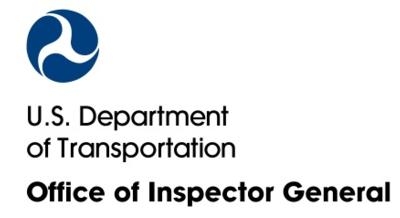Thu, Dec 08, 2016
Self-Initiated Audit Resulted In Six Recommendations To The Agency
Recognizing that the growing demand for civil Unmanned Aircraft Systems (UAS) operations presents new safety oversight challenges for the FAA, and given the significant and complex challenges of safely integrating UAS into the National Airspace System and the increasing number of UAS operations, the DOT Inspector General's office initiated an audit of FAA’s processes for approving civil UAS operations and overseeing the safe operation of UAS.

Using an authority granted by Congress, FAA has approved over 5,500 commercial UAS to operate by exempting them from regulatory requirements, and recently issued a final rule governing operations of small UAS.
In the audit, the IG found that FAA streamlined its process in 2015 for exempting civil UAS from regulatory requirements in response to increasing requests for exemptions and concerns over lengthy approval times. However, FAA’s process does not verify that operators actually meet or understand the conditions and limitations of their exemptions either before or after the application is approved. Furthermore, while FAA has taken some steps to advance UAS technology, the Agency has not established a risk-based safety oversight process for civil UAS operations—a key tool for focusing resources on a range of emerging risks. Despite an increase in reported UAS events, FAA lacks a robust data reporting and tracking system for UAS activity. As a result, FAA is currently taking a reactive approach to UAS oversight.
The IG's office recommended that the FAA do the following:
- Establish specific milestones to update and maintain UAS guidance to keep pace with technological developments and incorporate inspector feedback.
- Develop comprehensive and updated training for safety inspectors on UAS technologies and Agency rules and guidance related to UAS oversight.
- Initiate a periodic process to perform inspections of commercial UAS operators based on operational factors (e.g., location, number of operations, and type of activity) to verify knowledge of and compliance with FAA requirements and to inform the development of a risk-based oversight plan.
- Design and implement a risk-based and prioritized oversight plan for UAS to help ensure safe operations of UAS.
- Develop and implement a process to coordinate existing disparate UAS databases within FAA to facilitate data mining and safety analysis.
- Implement a process to share UAS data with field oversight offices to assist inspectors in risk-based and proactive oversight of civil UAS operations.
The IG said the FAA concurred with all six of its recommendations to enhance the effectiveness of FAA’s oversight of civil UAS. Based on FAA’s response, we consider two recommendations resolved but open, and we are requesting additional information for four recommendations.
(Source: DOT IG. Images from file)
More News
DETRESFA (Distress Phrase) The code word used to designate an emergency phase wherein there is reasonable certainty that an aircraft and its occupants are threatened by grave and i>[...]
"General aviation is at the forefront of developing and introducing innovative technologies that will transform the entire aviation industry..." Source: Kyle Martin, Vice President>[...]
Direct Straight line flight between two navigational aids, fixes, points, or any combination thereof. When used by pilots in describing off-airway routes, points defining direct ro>[...]
Aero Linx: Women in Corporate Aviation Women in Corporate Aviation support individuals seeking career advancement and professional development in the business aviation industry. Me>[...]
“We would like to thank the many volunteers that help throughout the year to pull off the event, as well as the several reviewers, judges, and SURVICE staff that provide team>[...]
 ANN's Daily Aero-Term (04.26.24): DETRESFA (Distress Phrase)
ANN's Daily Aero-Term (04.26.24): DETRESFA (Distress Phrase) Aero-News: Quote of the Day (04.26.24)
Aero-News: Quote of the Day (04.26.24) ANN's Daily Aero-Term (04.27.24): Direct
ANN's Daily Aero-Term (04.27.24): Direct ANN's Daily Aero-Linx (04.27.24)
ANN's Daily Aero-Linx (04.27.24) Aero-News: Quote of the Day (04.27.24)
Aero-News: Quote of the Day (04.27.24)



